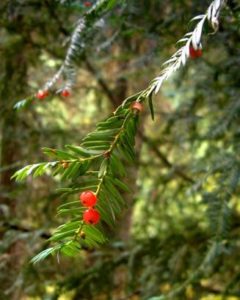By Eric Garris

As science and medicine evolves, we gain a greater understanding of the complexities of human diseases and potential curative properties of the species within the earth’s botanical resources. Researchers with the National Cancer Institute partnered with the USDA in the early 1960’s to evaluate possible anti-cancer agents within the world’s forests. Of the species tested, Pacific Yew, Taxus brevifolia, exhibited many properties which would deter and, in some cases, eliminate cancer cells.
The Pacific Yew was found throughout Northwestern North America, but was greatly exploited by pharmaceutical companies in need of its bark, which is used to make the widely used anti-cancer agent taxol. Some of this over-harvesting pressure has been reduced by synthesizing similar compounds using leaves from other Taxus species and by planting groves of Pacific Yew, to be harvested for medicinal use, insuring the availability of taxol. Even with concerted efforts, the species may become extinct from its native range as wild populations continue to decline due to loss of habitat from logging for paper and wood products in the forests the Pacific Yew calls home.
Want more Vanishing Acts? Click here to view the archive.
Vanishing Acts: Trees Under Threat was developed and produced by The Morton Arboretum in association with the Global Trees Campaign, a partnership between Fauna and Flora International and Botanic Gardens Conservation International.
Funding for this exhibit comes from The Morton Arboretum and the U.S. Institute for Museum and Library Services, Museums for America Grant Program.
Support locally comes from LG&E and KU. Additional support provided by Shepherdsville/Bullitt County Tourism.

